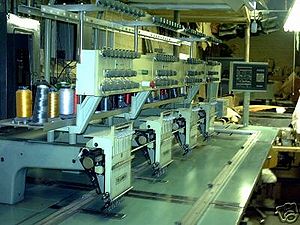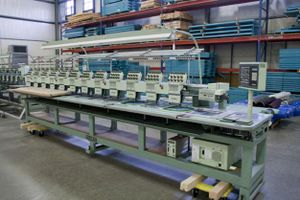Difference between revisions of "Tajima TME-HC"
| (4 intermediate revisions by the same user not shown) | |||
| Line 7: | Line 7: | ||
| embSeriesHeads = 4, 6, 12, 15, 20 | | embSeriesHeads = 4, 6, 12, 15, 20 | ||
| embSeriesNeedles = 6, 9 | | embSeriesNeedles = 6, 9 | ||
| embSeriesInput = Serial, Parallel, [[ | | embSeriesInput = Serial, Parallel, [[Floppy To USB]] | ||
}} | }} | ||
In 1990 Tajima released the TME-HC series embroidery machine. | {{for|the Tajima Embroidery Machine info|Tajima}} | ||
In 1990 [[Tajima]] released the TME-HC series embroidery machine. | |||
The TME-HC did not come with a floppy disk drive and only came with ports for external readers such as an external paper tape reader or Floppy Drive. | The TME-HC did not come with a floppy disk drive and only came with ports for external readers such as an external paper tape reader or Floppy Drive. | ||
The machine came in options of 4,6, 12, 15 or 20 heads. The machine only had manually removable table tops (nothing automatic). The machine was only available as 6 or 9 needles. | ==Tajima TME-HC== | ||
{{for|the Tajima TME-HC machine electronics info|Tajima TME-HC Electronics}} | |||
''For the Tajima TME-HC user manual see [http://www.plrelectronics.com/lab/Tajima/Manual/tajima_tme_hc_user_manual.php Tajima TME-HC User Manual]'' | |||
The Tajima TME-HC machine came in options of 4,6, 12, 15 or 20 heads. The machine only had manually removable table tops (nothing automatic). The machine was only available as 6 or 9 needles. | |||
[[File:Tajima TME-HC904-1991-A.jpg|thumb|right|alt=Tajima TME-HC904 First Generation with separate pretension bar|Tajima TME-HC904 First Generation with separate pretension bar]] | [[File:Tajima TME-HC904-1991-A.jpg|thumb|right|alt=Tajima TME-HC904 First Generation with separate pretension bar|Tajima TME-HC904 First Generation with separate pretension bar]] | ||
===1990-1992=== | |||
In 1990 Tajima released their first TME-HC model. The original HC models had mechanical thread break detectors that ran off a mechanical cam system. When the machine made a color change, the lob of the cam would physically close the thread break detection circuit. The HC models from this era had pretension knobs apart from the heads located in front of the mechanical thread break detection system. | In 1990 [[Tajima]] released their first TME-HC model. The original HC models had mechanical thread break detectors that ran off a mechanical cam system. When the machine made a color change, the lob of the cam would physically close the thread break detection circuit. The HC models from this era had pretension knobs apart from the heads located in front of the mechanical thread break detection system. | ||
[[File:BORDADORA-TAJIMA-TME-HC-CABEZAS-9-HILOS.jpg|thumb|right|alt=Tajima TME-HC912 Second Generation with attached pretension |Tajima TME-HC912 Second Generation with attached pretension]] | [[File:BORDADORA-TAJIMA-TME-HC-CABEZAS-9-HILOS.jpg|thumb|right|alt=Tajima TME-HC912 Second Generation with attached pretension |Tajima TME-HC912 Second Generation with attached pretension]] | ||
===1993-1994=== | |||
The TME-HC machines released after 1992 came with standard [[DU-10]] power boxes for the X and Y card. Each head was equipped with individual thread break boards and sensors, replacing the original HC design. The machines from this era looked much more like their predecessor, the TME-DC. The last TME-HC machine was produced in 1994. | The TME-HC machines released after 1992 came with standard [[DU-10]] power boxes for the X and Y card. Each head was equipped with individual thread break boards and sensors, replacing the original HC design. The machines from this era looked much more like their predecessor, the TME-DC. The last TME-HC machine was produced in 1994. | ||
=== TME-HC Specifications === | |||
{{for|the Tajima TME-HC machine dimension info|Embroidery Machine Dimensions}} | {{for|the Tajima TME-HC machine dimension info|Embroidery Machine Dimensions}} | ||
Latest revision as of 20:01, 11 September 2013
{{#invoke:Infobox|infobox}}
In 1990 Tajima released the TME-HC series embroidery machine.
The TME-HC did not come with a floppy disk drive and only came with ports for external readers such as an external paper tape reader or Floppy Drive.
Tajima TME-HC
For the Tajima TME-HC user manual see Tajima TME-HC User Manual
The Tajima TME-HC machine came in options of 4,6, 12, 15 or 20 heads. The machine only had manually removable table tops (nothing automatic). The machine was only available as 6 or 9 needles.
1990-1992
In 1990 Tajima released their first TME-HC model. The original HC models had mechanical thread break detectors that ran off a mechanical cam system. When the machine made a color change, the lob of the cam would physically close the thread break detection circuit. The HC models from this era had pretension knobs apart from the heads located in front of the mechanical thread break detection system.
1993-1994
The TME-HC machines released after 1992 came with standard DU-10 power boxes for the X and Y card. Each head was equipped with individual thread break boards and sensors, replacing the original HC design. The machines from this era looked much more like their predecessor, the TME-DC. The last TME-HC machine was produced in 1994.
TME-HC Specifications
| Model | Heads | Needles | EMB Space / Head | Max SPM | Pwr Cons. | Years | Color |
|---|---|---|---|---|---|---|---|
| TME-HC606 (G1) | 6 | 6 | emb Space | SPM | POWEW | 1990-1992 | Green |
| TME-HC612 (G1) | 12 | 6 | emb Space | SPM | POWEW | 1990-1992 | Green |
| TME-HC904 (G1) | 4 | 9 | emb Space | SPM | POWEW | 1990-1992 | Green |
| TME-HC906 (G1) | 6 | 9 | emb Space | SPM | POWEW | 1990-1992 | Green |
| TME-HC912 (G1) | 12 | 9 | emb Space | SPM | POWEW | 1990-1992 | Green |
| TME-HC906 (G2) | 6 | 9 | emb Space | SPM | POWEW | 1993-1994 | Green |
| TME-HC912 (G2) | 12 | 9 | emb Space | SPM | POWEW | 1993-1994 | Green |
Tajima Legend
Tajima used several codes in their models that described basic features of the machines. The letters in the model number usually
- TME
- Machines with TME in their model without any other letters (numbers only) is a very late 1970s - 1990 flat only machine.
- TME-C
- Predecessor to the TME, a Tajima machine with a C in it represents Cylinder (tubular) embroidery. Therefore machines with the letter C in their model, have removable tables.
- TME-HC, TMEF-H, H
- Models with H in their model have the H model control panels. A TME-HC is an Arm Type machine with removable tables and the H model control panel. A TMEF-H machine is a flat machine with the H model control panel.
- TMEF
- Machines with the F code are Bridge Machine (not arm type). If there are not more letter codes then this machine is a flat only machine (does not to tubular or caps).
- TMM
- TMM machines were collaboration Melco and Tajima machines. These machines have a Melco control panel/keyboard.
Tajima Years, Date or Age
The year of the Tajima machine can usually be found on a sticker behind the machines control panel or power boxes. These years are usually the year that the machines electronics were Quality Control checked at the Japan factory. The months listed on these stickers will probably be different. It usually took about 3 months from production to delivery to the original customers location. Later models had the production year stamped on the data plate.
If the machine is old and does not have a sticker, then the machine is probably older than 1990.
Buying
Tajima embroidery machines are probably one of the best machines on the market. They are more expensive that most all competing models but, they are very solidly built and have a good resell market. There are a lot of embroidery machine technicians available world wide and parts are pretty easy to find even for older models.
Selling
TheEmbroideryWarehouse buys and sells most every make and model of Tajima embroidery machines located within the continental USA. They also purchase parts, parts machines, salvage machines and most everything else related to embroidery equipment.

